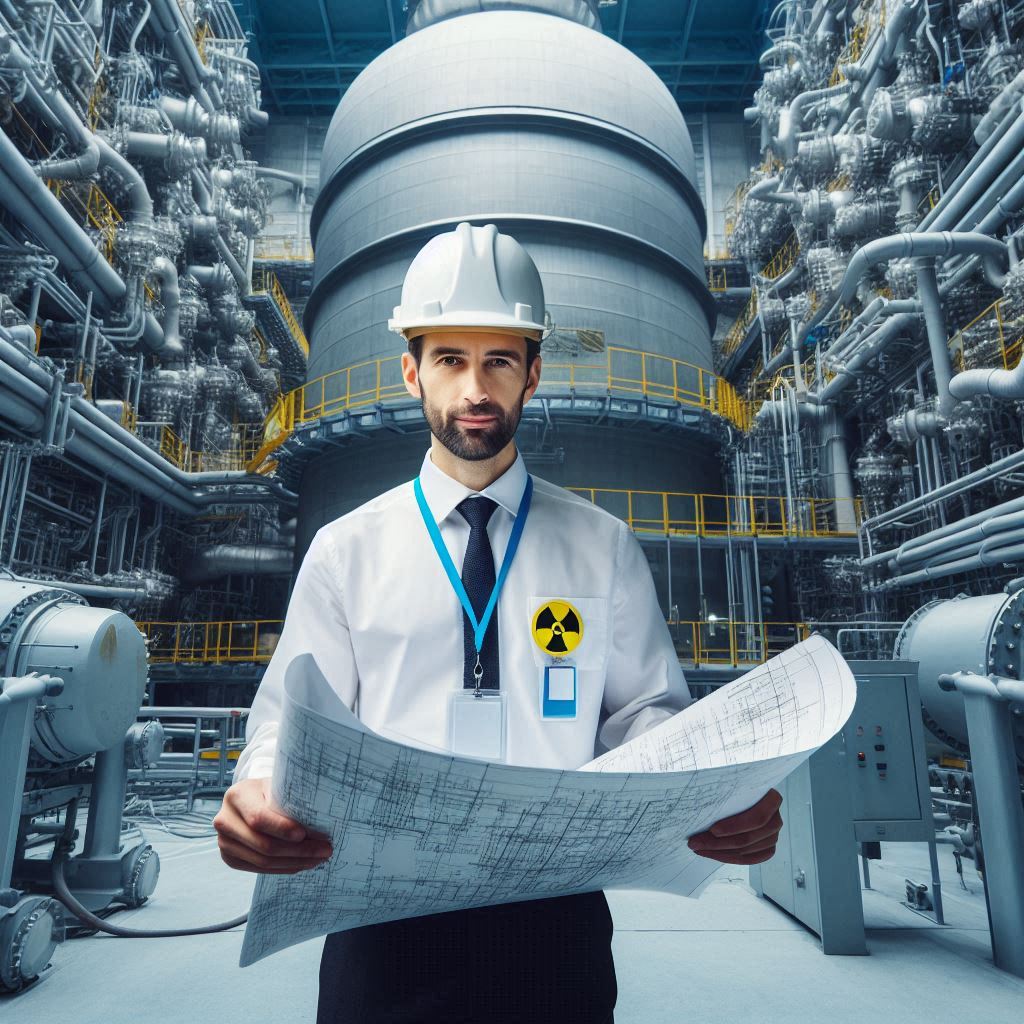Introduction
Nuclear Engineering and Its Importance in Various Industries
Nuclear engineering plays a pivotal role in various industries, from energy production to medicine.
It involves designing, developing, and maintaining systems that harness nuclear processes.
This field is crucial for generating clean energy, advancing medical treatments, and supporting national security.
The innovations in nuclear technology impact diverse areas, enhancing both industrial efficiency and public health.
The Need for Interdisciplinary Collaborations in Nuclear Engineering
Given the complexity and rapid technological advancements in nuclear engineering, interdisciplinary collaborations are essential.
Combining expertise from physics, engineering, chemistry, and computer science is crucial for addressing intricate challenges.
These collaborations drive innovation and ensure comprehensive solutions, making them vital for the field‘s continued progress and success.
Effective teamwork and communication among experts from various disciplines are key to advancing nuclear technology and overcoming emerging challenges.
Overview of nuclear engineering
Nuclear Engineering and Its Applications
Nuclear engineering focuses on harnessing nuclear reactions for energy and various applications.
It involves the design, operation, and maintenance of nuclear systems.
This field merges principles from physics, chemistry, and engineering to manage nuclear reactions and their by-products.
Nuclear engineers work on systems that use nuclear energy for power generation, medical treatments, and industrial processes.
Their expertise is essential in developing and managing technologies that rely on nuclear reactions.
The Role of Nuclear Engineers in Designing, Operating, and Maintaining Nuclear Power Plants
Nuclear engineers play a crucial role in advancing energy technology.
They design nuclear reactors, ensuring safety and efficiency.
Their work involves creating systems that control nuclear reactions and produce energy sustainably.
Engineers also develop new reactor designs, aiming for improved performance and reduced waste.
In power plants, nuclear engineers manage daily operations.
They oversee reactor performance, making sure operations adhere to safety regulations.
Engineers monitor systems to prevent malfunctions and address any issues promptly.
Their role is vital to ensure that nuclear power remains a reliable energy source.
Maintenance is another key responsibility.
Engineers perform regular checks and repairs to keep systems functioning optimally.
They analyze data from reactor operations to predict potential problems and prevent failures.
Through maintenance, engineers extend the life of equipment and ensure consistent energy output.
Nuclear engineers also handle radioactive materials.
They design systems to safely manage waste and mitigate environmental impact.
This involves developing methods for storing and disposing of radioactive by-products securely.
Engineers work to minimize the ecological footprint of nuclear power generation.
Training and education are essential parts of the role.
Engineers must stay updated with technological advancements and regulatory changes.
Continuous learning helps them adapt to new challenges and integrate innovative solutions into their work.
In addition to power plants, nuclear engineering finds applications in medicine and industry.
Engineers design medical devices that use radioactive materials for diagnosis and treatment.
They also develop industrial techniques that utilize nuclear technology for inspection and analysis.
Overall, nuclear engineering combines scientific knowledge with practical skills to address global energy needs.
The discipline requires a deep understanding of nuclear physics and engineering principles.
Engineers must navigate complex safety standards and technological challenges to contribute to a sustainable energy future.
Their work ensures that nuclear technology continues to benefit society safely and efficiently.
Read: The Role of Aerospace Engineers in Satellite Development
Importance of interdisciplinary collaborations
The Complexity of Nuclear Engineering Projects
Nuclear engineering projects are inherently complex due to the intricate nature of nuclear reactions and their management.
Designing and operating nuclear systems involve numerous interconnected components, each with its own set of challenges.
Reactors must be engineered to handle high-energy reactions safely while maintaining efficiency and reliability.
Engineers must consider factors like thermal dynamics, radiation shielding, and waste management, all of which interact in complex ways.
The stakes are high; any failure can have significant safety, environmental, and economic repercussions.
This complexity necessitates a multidisciplinary approach to address the multifaceted problems inherent in nuclear technology.
The Need for Expertise from Various Fields
To navigate the challenges of nuclear engineering, expertise from various fields is crucial.
Physics provides the foundational understanding of nuclear reactions and radiation.
This knowledge is essential for designing reactors and predicting how they will behave under different conditions.
Chemistry is vital for managing radioactive materials and ensuring that chemical processes within reactors function correctly.
Chemists develop methods for handling and processing nuclear fuels and waste.
Materials science is another critical area, as engineers need to select and develop materials that can withstand extreme conditions, such as high radiation levels and intense heat.
The combined expertise from these fields helps to create comprehensive solutions that address the diverse needs of nuclear engineering projects.
In summary, the complexity of nuclear engineering projects demands a collaborative approach that integrates knowledge from multiple disciplines.
By drawing on physics, chemistry, and materials science, engineers can effectively tackle the challenges of designing, operating, and maintaining nuclear systems.
This interdisciplinary collaboration ensures that all aspects of nuclear technology are managed efficiently and safely, leading to more robust and innovative solutions.
Read: Aerospace Engineering in Commercial Spaceflight
Examples of interdisciplinary collaborations
Collaborations Between Nuclear Engineers and Environmental Scientists
Nuclear engineers often collaborate with environmental scientists to assess and mitigate the environmental impact of nuclear energy.
Environmental scientists study how nuclear plants affect local ecosystems, air quality, and water resources.
These experts analyze data on radiation levels, waste management practices, and the long-term effects of radioactive by-products.
They provide critical insights into how nuclear operations can be adjusted to minimize environmental damage.
For example, they might suggest improvements in waste storage techniques to prevent contamination of soil and water.
By working together, nuclear engineers and environmental scientists ensure that nuclear energy is harnessed in a way that protects natural resources and human health.
Collaborations Between Nuclear Engineers and Civil Engineers
The collaboration between nuclear engineers and civil engineers is crucial in the construction and maintenance of nuclear facilities.
Civil engineers focus on designing and building the infrastructure required for nuclear plants, including reactor buildings, cooling systems, and containment structures.
They ensure that these structures meet stringent safety and durability standards.
Nuclear engineers contribute their expertise in reactor design and operational safety to guide the construction process.
This partnership ensures that the physical infrastructure supports the safe and efficient operation of nuclear systems.
For instance, civil engineers might design reinforced containment buildings to withstand potential seismic events, while nuclear engineers ensure that these designs align with the technical requirements of reactor systems.
In summary, interdisciplinary collaborations enhance the effectiveness and safety of nuclear engineering projects.
Working with environmental scientists helps address ecological concerns, while partnering with civil engineers ensures robust and safe facility infrastructure.
These collaborations are essential for advancing nuclear technology while safeguarding both the environment and public safety.
Read: Essential Aerospace Engineering Textbooks

Challenges of Interdisciplinary Collaborations
Communication Barriers Between Experts from Different Fields
Interdisciplinary collaborations often face communication barriers due to differences in terminology and approaches among experts from various fields.
For example, a nuclear engineer might use technical jargon specific to reactor design, while an environmental scientist may focus on ecological impacts with its own set of terminologies.
These differences can create misunderstandings or misalignments in project goals.
Effective communication requires both sides to make an effort to understand each other‘s language and concepts.
Regular meetings and joint workshops can help bridge these gaps, fostering clearer dialogue and better collaboration.
It‘s essential for teams to establish common ground and ensure that all members are on the same page to achieve project objectives.
The Importance of Having a Common Goal and Understanding Among Collaborators
Having a shared goal is crucial for successful interdisciplinary collaborations.
When nuclear engineers and environmental scientists work together, they must align their objectives to ensure that all efforts contribute toward a unified purpose.
Without a common goal, the collaboration can become fragmented, with different experts pursuing conflicting or disconnected outcomes.
A mutual understanding of the project‘s overall aim helps in coordinating efforts and integrating expertise effectively.
It also fosters a sense of teamwork and commitment to achieving the desired results.
Clear communication of goals and regular progress reviews are vital to maintaining this alignment and ensuring that all contributions are directed towards solving the problem at hand.
In summary, interdisciplinary collaborations face challenges such as communication barriers and the need for a unified goal.
Addressing these issues through effective communication and a shared vision helps in overcoming obstacles and achieving successful outcomes.
By fostering understanding and aligning objectives, collaborators can work together more effectively to address complex problems and advance their projects.
Read: The Impact of Aerospace Engineering on Modern Life
Benefits of Interdisciplinary Collaborations
How Diverse Expertise Can Lead to Innovative Solutions in Nuclear Engineering Projects
Diverse expertise significantly enhances innovation in nuclear engineering projects.
When experts from different fields‘such as nuclear engineering, materials science, and environmental science‘collaborate, they bring unique perspectives and skills to the table.
This blend of knowledge can lead to creative problem-solving and novel approaches that might not emerge within a single discipline.
For example, combining insights from materials scientists and nuclear engineers can result in the development of new materials that improve reactor performance and safety.
Likewise, environmental scientists’ input can lead to innovative waste management solutions.
By integrating diverse expertise, teams can tackle complex challenges more effectively and develop groundbreaking technologies.
How Collaborations Can Improve Safety and Efficiency in Nuclear Facilities
Interdisciplinary collaborations can significantly enhance the safety and efficiency of nuclear facilities.
For instance, civil engineers and nuclear engineers working together can design robust reactor containment structures that better withstand external threats.
Environmental scientists’ input helps in developing safer waste disposal methods and minimizing environmental impacts.
These collaborations ensure that safety protocols are comprehensive and that operational practices are optimized for efficiency.
Furthermore, regular communication and shared expertise among different disciplines can lead to early identification and mitigation of potential risks, thereby improving overall safety.
Enhanced efficiency in operations and maintenance processes also results from the combined knowledge and problem-solving capabilities of diverse teams.
In summary, interdisciplinary collaborations offer substantial benefits, including innovative solutions and improved safety and efficiency in nuclear engineering projects.
By leveraging diverse expertise, teams can address complex challenges more effectively and advance nuclear technology in a way that is both safe and efficient.
Case studies of successful interdisciplinary collaborations
Examples of Projects Where Collaborations Between Different Disciplines Led to Successful Outcomes
One notable example is the development of advanced reactor designs, such as the Integral Fast Reactor (IFR) project.
This initiative involved nuclear engineers, materials scientists, and environmental scientists working together to create a more efficient and safer reactor.
Materials scientists developed new alloys and composite materials that could withstand higher radiation levels and extreme temperatures.
Environmental scientists contributed expertise in waste management to ensure that the reactor’s by-products were handled safely.
This collaboration led to a design that not only improved reactor efficiency but also reduced long-term waste.
Another successful case is the Fukushima Daiichi Nuclear Power Plant‘s post-accident recovery efforts.
After the 2011 disaster, a diverse team of nuclear engineers, civil engineers, and environmental scientists came together to address the crisis.
Civil engineers focused on strengthening the plant‘s infrastructure to prevent future damage.
Nuclear engineers worked on stabilizing the reactors and managing the fuel.
Environmental scientists helped assess and mitigate the environmental impacts of the accident.
This interdisciplinary approach was crucial in managing the immediate crisis and developing long-term recovery strategies.
The Key Factors That Contributed to the Success of These Collaborations
Several key factors contributed to the success of these interdisciplinary collaborations.
First, clear communication was essential.
Team members from different disciplines made efforts to understand each other‘s terminology and concepts, ensuring that all contributions were integrated effectively.
Second, a shared vision and common goals helped align the efforts of all team members.
In both the IFR project and the Fukushima recovery, the collaborators focused on a unified objective, whether it was developing a safer reactor or managing a crisis effectively.
Third, strong leadership played a critical role.
Leaders from each discipline facilitated collaboration by coordinating efforts, setting clear objectives, and ensuring that all voices were heard.
Finally, regular and structured meetings allowed team members to discuss progress, address issues, and adjust strategies as needed.
This approach kept the project on track and ensured that all disciplines worked towards the common goal effectively.
In summary, successful interdisciplinary collaborations often involve clear communication, a shared vision, strong leadership, and structured meetings.
These elements ensure that diverse expertise is effectively integrated, leading to successful outcomes in complex projects.
Learn More: Day in the Life of an Engineering Technician: Insights
Transform Your Career Today
Unlock a personalized career strategy that drives real results. Get tailored advice and a roadmap designed just for you.
Start NowConclusion
The Importance of Interdisciplinary Collaborations in Nuclear Engineering
Interdisciplinary collaborations are essential in nuclear engineering to drive progress and innovation.
Combining expertise from physics, engineering, chemistry, and computer science leads to breakthroughs that enhance safety and efficiency.
Each discipline brings a unique perspective that, when integrated, accelerates problem-solving and research development.
This blend of skills and knowledge fosters innovation and helps address complex challenges in the field.
The Need for Cooperation and Communication Among Experts from Various Fields to Advance the Field of Nuclear Engineering
Effective communication and teamwork are vital for advancing nuclear engineering.
Experts from various fields must cooperate closely to develop comprehensive solutions and tackle intricate problems.
Interdisciplinary partnerships enable the exchange of ideas and expertise, which is crucial for pushing the boundaries of technology.
The future of nuclear engineering relies on these collaborations to ensure continued progress and innovation.
By embracing cooperation and maintaining open lines of communication, professionals can address emerging challenges and contribute to a safer and more efficient nuclear industry.
These collaborative efforts are key to advancing the field and achieving groundbreaking results.
[E-Books for Sale]
The Big Book of 500 High-Paying Jobs in America: Unlock Your Earning Potential
$19.99 • 500 High-Paying Jobs • 330 pages
Explore 500 high-paying jobs in America and learn how to boost your career, earn more, and achieve success!
See All 500 High-Paying Jobs of this E-Book
1001 Professions Without a Degree: High-Paying American Jobs You Can Start Now
$19.99 • 1001 Professions Without a Degree • 174 pages
Discover 1001 high-paying jobs without a degree! Unlock career tips, skills, and success strategies for just $19.99!




